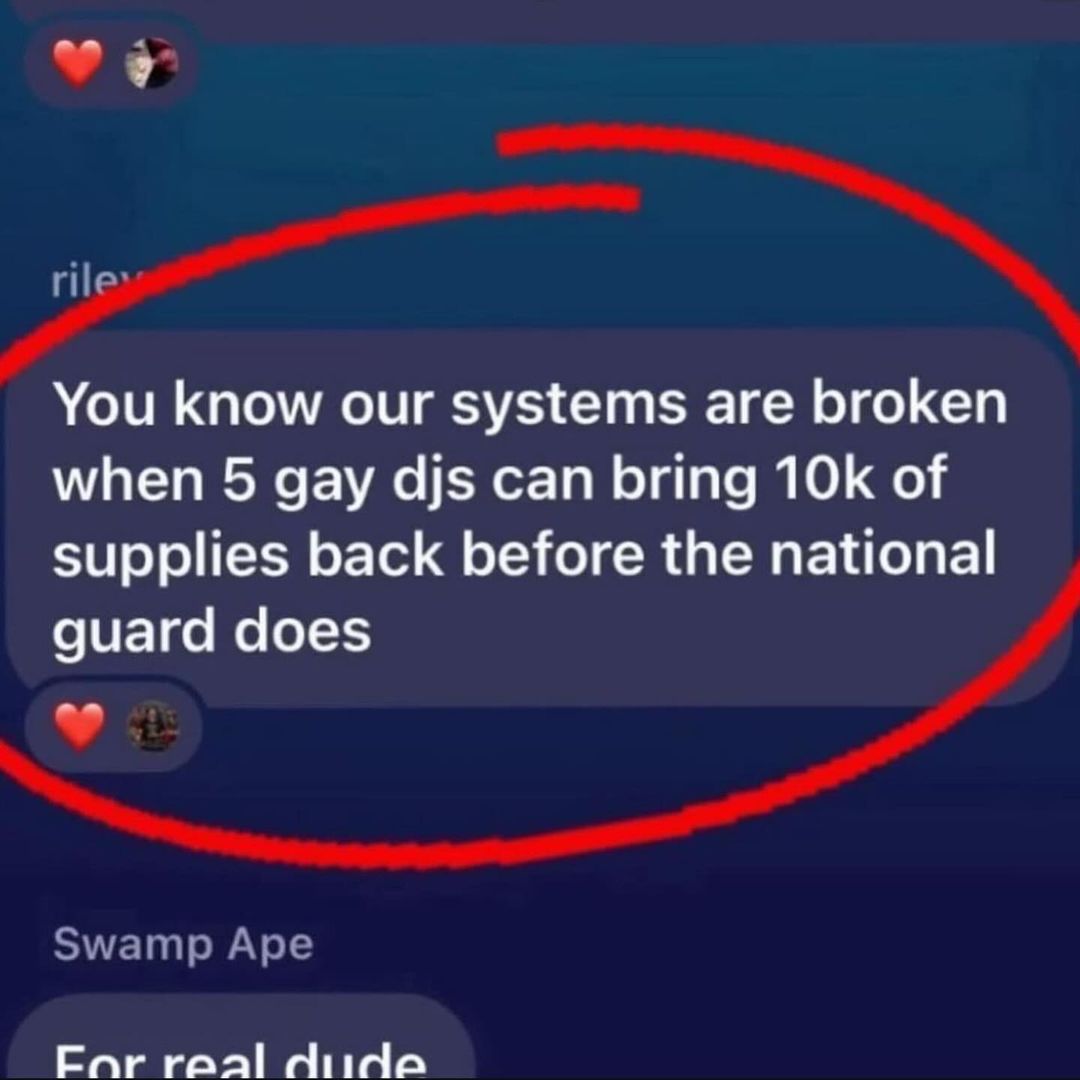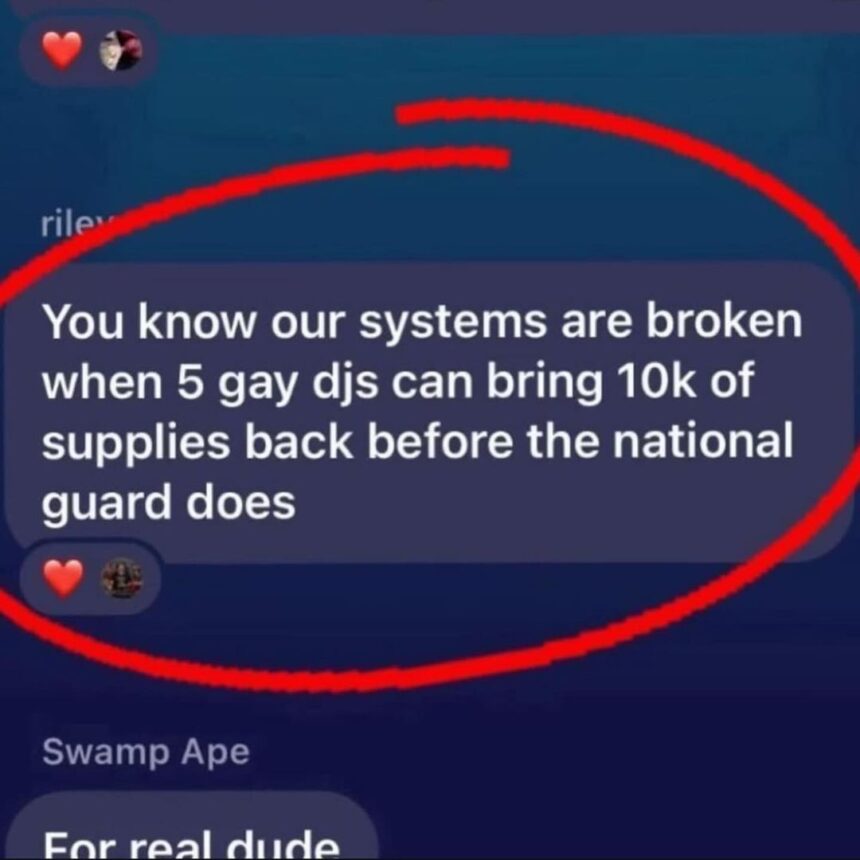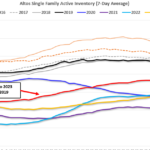We’ve repeatedly chronicled increasingly visible and consequential examples of failures in organizational capabilities. The degree of institutional brain rot has become disconcertingly visible in recent years, particularly among top national officials and international institutions (we’re looking at you, Ursula). These shortcomings are set to become a critical lapse as climate change related disasters become more frequent and severe.
Now admittedly, the effects on communities can be blunted by preparation, such as relocating away from vulnerable area and requiring buildings to be more flood and wind resistant, as well as better infrastructure, like micro-grids to allow for faster restoration of electricity in an emergency. But then we’ve had utterly bone-headed action, like allowing telcos to end copper-wire phone service so they could escape common carrier rules, aka regulation. That copper wire had its own power and so worked when power lines were down. Citizens now are on their own, dependent on cell phones with limited battery life during disasters. They might as well have semaphores. I recall during Hurricane Sandy how residents of the dark zone in Manhattan roughly below 40th Street, where power was out for days, would walk (sometimes long distances) to where the lights were on to power their phones and make calls.
A more extreme version of lack of preparedness is Valencia. Even though the rainfall was extreme, the impact was made much worse by the lack of storm drains:
The scale of the flooding currently unfolding in Valencia, Spain is unfathomable. This is footage from Chiva, where a jaw-dropping 343 mm of rain was recorded in just 4 hours earlier today, between 4:30 PM and 8:30 PM.
Video credit: Nalabcer pic.twitter.com/WdCgUifavQ
— Nahel Belgherze (@WxNB_) October 29, 2024
@juneslater17 Why was Valencia was under water? A part of the city is built on ground without drainage. Also 100
000ends of trees were chopped and roots removed. All for new high-rises. The (artificial) rainwater has nowhere to go. Here the sky 1 day before the rain disaster. pic.twitter.com/g6j6e1wasu— Th.R. (80+) 🇳🇱🇩🇪🇫🇴🇪🇦 (@trebergen) November 2, 2024
This flood does appear to be poor design.
Valencia city had no flooding – all of the floods were in the southern suburbs. So why did this happen? I have seen no breach in the storm-drain levies as yet.
— ralph ellis (@ralfellis) November 2, 2024
In other words, the flooding did not have to be this bad.
Another vector of failure was the lack of official warnings:1
🚨Angry residents in Valencia, throw mud at the Spanish king after it became known that residents were warned too late about flood by civil authorities which lead to kill more than 150 people#Valencia #SpanishPM #Spain pic.twitter.com/Vxr0SAxD0I
— GOGINENI (@gogineni_X) November 3, 2024
And this level of citizen action is gratifying, but not sufficient on its own:
Today is public holiday in Spain and literally thousands of people in Valencia came out to help the victims of the October 29 disaster armed with shovels and brooms.
A flood of people against the flood of water.pic.twitter.com/7WsTT8CbuT
— Massimo (@Rainmaker1973) November 1, 2024
It may seem strained to discuss the poor long-term planning and emergency responses in Valencia to official performance in the US after Helene. But we are going to see more and more instances of climate disasters meeting infrastructure that either didn’t or inadequately contemplated severe floods and winds. Keeping tabs on them, particularly across countries, can help develop lessons.
To turn to FEMA and Helene, it would be nice to perform a Lambertian deep dive and assemble clips across a wide range of sources. However, I am not confident of how informative it would really be, since the reporting on the official responses to this disaster has a “dog that didn’t bark” quality to it. So I will instead use Helene as a point of departure for examining higher-level issues.
The reasons to question the caliber of government responses are the paucity of stories either giving favorable coverage of FEMA’s action, either overall or heart-warming anecdata. An obvious reason is the geographic remoteness of many of the hard-hit areas in a generally media-poor part of the US. Contrast that with Katrina, which took place in a major metropolitan/commercial center, familiar to most reporters, with a large airport and many highways. 2005 was also early in the hollowing-out of newsrooms.
By all accounts, Asheville, NC, which was particularly hard hit and more accessible by result of being a relatively large city, is still in recovery mode more than a month after the storm hit. Notice how the House Majority Leader Steve Scalise visited North Carolina on November 1 with a North Carolina representative and representatives from other states. Further notice the lack of mention, let alone praise, for FEMA. From his press release:
Yesterday, House Majority Leader Steve Scalise (R-La.) visited Asheville, North Carolina with Congressman Chuck Edwards (R-N.C.) alongside Congressman Jason Smith (R-Mo.), Congressman Mark Alford (R-Mo.), and Congressman Mike Collins (R-Ga.) to tour communities devastated by Hurricane Helene. Leader Scalise met with local officials, volunteers, and small business owners working to rebuild and released the following statement:
“Hurricane Helene had a devastating impact across western North Carolina. But I saw in Asheville today what I saw in New Orleans after Hurricane Katrina: resilient people coming together in the face of destruction and tragedy to lend helping hands to their neighbors and rebuild their vibrant community. I’m thankful to have been here to see the challenges firsthand and to meet many of the incredible volunteers, restaurateurs, and business owners already working to restore what was lost. My friend Congressman Chuck Edwards is working tirelessly in the wake of this storm to help these hard-hit areas and aid them on their road to recovery. North Carolina is not alone in this fight.”
Even though this recent local account (five days old) does praise FEMA, it seems to unintentionally reveal shortcomings in official responses to disasters of this scale:
It has been a month since the storm, and there are still many roads closed and homes without power. The city water is unfit to drink; we have to boil it even to wash dishes, and what flows from the tap is a cloudy, rust-colored fluid. It has been so bad and left so many people stranded or homeless that Jose Andres’ World Central Kitchen has come to feed those in need.
At our house, we were otherwise lucky. Our neighborhood had fewer fallen trees than others, and we were high enough in elevation that we avoided the flooding. Beyond our little neighborhood, though, it looked very, very much like the devastation of Katrina.
The first week after the storm was hellacious. No power; no water; no phone; no wifi; no cable; no air conditioning. Dark at 7:00 p.m., and no lights anywhere. The fridge and freezer sat silent. On the fourth day, we had to throw out all the food in both and scrub the interiors with bleach to kill the faint smell of mold. With no water, we could not flush the toilets and, being unable to stop the physiology of the human body, we had to go somewhere. The commodes were becoming rank….
And it was a huge military operation: National Guard and Marines; search-and-rescue operations looking for people cut off from roads or stranded on roofs; dog teams looking for bodies in the debris. I have since heard ignorant people spout conspiracy theories about the failures of FEMA or the government in general, but those trolls weren’t there. I have never been so impressed at the seriousness and effectiveness of everyone, government or civilian working, to recover. The lies being spouted are reprehensible. Evil, actually.
The Asheville airport was covered with military planes and scores of copters. The only way into the area for the first days was by air. I-40, the main highway, was cut off on both ends by landslides. The bridges along I-26 were washed out. All roads in and out of Buncombe County were blocked and closed. If we had wanted to leave, we couldn’t.
This article is not at all clear on the military operation was about, but it seems to have been concentrated on the mentioned search and rescue. While that is critically important, one has to wonder why the official disaster response did not encompass other predictable needs, such as for clean water and food (why is World Central Kitchen the lead actor?)
A patchwork approach is a feature, not a bug. As FEMA defenders and readers have pointed out, it was never designed to be a first responder. But in a world where ISR (intelligence, surveillance, and reconnaissance) is a central component of military operations, why are those capabilities not being applied to large scale disasters? Why are localities and states required to go through the game of escalation based on fragmented on-the-ground demands before drone fleets are deployed to report back the scale and nature of destruction and identify humans who seem to be in trouble? Given the storm path and widely anticipated severity, why were they not pre-positioned?
One can argue that this approach is the result of America’s federal structure. I don’t buy it for a second. In banking, the Federal government has pre-empted nearly all banking oversight that formerly fell to state authority. For instance would be possible to have a mandate for Federal action once a hurricane was predicted to exceed certain levels (say severity of predicted winds and rain and size of exposed population). But that would put the Feds more in charge and therefore more accountable. Can’t have that, now can we?
Instead, we have this sort of thing. I personally find it weird that the not just the Vox interviewer but more important, interviewee Claire Connolly Knox, founder of the Emergency and Crisis Management program at the University of Central Florida in Orlando, depicts a balkanized and therefore cumbersome response to big disasters as hunky-dory and even worse, inevitable.
Mind you, a great deal of ad-hocracy, overlapping roles and just plain scrambling are inevitable when confronted with a big emergency. But there should be an effort to establish backbones quickly, most of all of gathering and dissemination of information. I don’t see that here. Instead, the piece starts with sanctimoniousness about not spreading disinformation, which has the effect of tamping down reports of real problems and shortcomings. It’s as if not harming Team Biden-Harris was more important than improving disaster relief efforts over time.
From interviewer Umair Irfan at Vox in Is FEMA messing up? An expert weighs in:
Umair Irfan
How would you evaluate their (FEMA’s) response? Are they graded on a curve when it comes to a disaster like this? And should FEMA have seen this coming and done more?
Claire Connolly Knox
Every disaster starts and ends locally, so every disaster response starts at the local level, and it ends at the local level. A lot of people don’t realize that. They think immediately of FEMA. FEMA has the purse strings, they help pay for a lot of this.
But the response is local. It goes to the state if locals can’t handle it. The state then does an emergency declaration to release additional funds. If it’s going to be more than they can handle, they go to their FEMA region. That then goes up to FEMA national, and then to the president for an emergency declaration or disaster declaration depending on which is needed.
Every state adheres to the same standards set forth by FEMA to have a comprehensive emergency management plan to train their local emergency managers to have the capacity to respond to a disaster.
Knox does dutifully cite how the Federal Stafford Act dictates how emergency aid operates, and how states have also set up mutual aid arrangements to supplement that. And she explains how FEMA has tried to become more pro-active in the wake of Katrina, with some arguable success in Hurricane Sandy, despite conservative and state/local pushback.2
Contrast this “‘just-so’ story” with some contrasting accounts. From We Are The Relief: How Queer Appalachian Mutual Aid Showed Up After Helene:

As the image circulated widely, I soon discovered that the five DJs — only two of whom are actually DJs — are part of the queer mutual aid organization Pansy Collective. Within 48 hours of the storm, they had partnered with the Mutual Aid Disaster Relief network, which was formed after Hurricane Sandy. Alongside The Pinhook in Durham, NC, they gathered physical donations and purchased additional supplies with the funds they raised. Long before FEMA had any presence in Western North Carolina, Pansy Collective distributed six truckloads, two trailers, and a box truck filled with non-perishable food, water, cleaning supplies, diapers, gas and gas cans, toiletries, batteries, and hygiene products to various hubs, including remote mountain locations where residents were unable to leave….
Ri, a Pansy Collective organizer, says that the collective’s remarkable ability to respond so quickly to devastation caused by Helene came from experience gained during the COVID-19 pandemic. “The framework of community care became a central concern across the country when COVID hit, and COVID kind of radicalized people too, Ri told Them. “The networks of mutual aid have grown and continue to have a strong presence in Asheville because Covid just happened.”
Moving forward, the collective wants to continue being a lifeline for as many types of people affected by the storm as possible. With funds from the influx of support that came after Helene, the group will keep redistributing aid as they simultaneously launch a bailout initiative for people arrested during the crisis of the storm, as well as a service worker and sex worker microgrant program for those left out of work.
From the other end of the ideological spectrum, Unherd provides data that suggests that Helene was a bigger disaster than Katrina yet received fewer Federal resources:
Bush’s response to Katrina was criticised at the time for being lumberingly slow and ineffective. But the relief effort being mounted now is a pale shadow of what was done a mere 19 years ago, and that makes the silence around this disaster even more ominous.
In 2005, significant planning and resourcing was being carried out days before the storm even made landfall. Ten thousand members of the National Guard had gathered from several states to deal with the damage Katrina was about to cause. The final number who helped with the effort measured closer to 20,000. But those guardsmen did not stand alone: the US Army was preparing to assume overall command of the entire rescue effort through US Northern Command, where its battle staff coordinated response forces over various state lines. The regular Army helped too, including forces from the 82nd Airborne Division and the Army Corps of Engineers…..
This time, things are very different. At the time of writing, fewer than 7,000 guardsmen are helping with Helene disaster relief, and there was no equivalent preparation before the storm actually hit. US Northern Command, which can only assume responsibility if it is asked to do so by other government authorities, is not coordinating the overall effort. During Katrina, more than 350 military helicopters were involved with the rescue efforts. This time, in a mountain disaster zone where many more helicopters are needed than in a coastal area, well below 100 helicopters have currently been committed……
Appalachia has always been forgotten; the people there are used to being treated like dirt. Talking to locals whose families were still stuck in the disaster area, the common refrain was that the help wasn’t arriving because the elites simply hate the people now in need of help. Talking to people in D.C., however, quickly dispelled that notion. What is going on right now isn’t malice, it’s somehow even worse: it’s senility. People weren’t enjoying the suffering of fellow Americans; they were simply so oblivious and zoned out that they couldn’t even notice a problem.
Currently, a hurricane disaster that is significantly more challenging than Katrina is being serviced by something like a third of the resources that Louisiana called upon. And yet few people in Washington even think this is a problem. At the same time as Congress has borrowed another 10 or 20 billion dollars to hand over to Ukraine and Israel, presidential candidate Kamala Harris has announced that the victims of Helene will be able to apply for $750 in relief assistance to help them get back on their feet.
My sources have no reason to lie. Perhaps some exaggeration but it all seems too likely to me.
FEMA is a charlie foxtrot, whatever its apologists and administrators say. Almost every person who applies for the $750 is denied. For example, if you have insurance, no $750 because your benevolent insurance company will pay. Yeah, but for many, only after being dragged kicking and screaming to cut the check. An assistant rents her house in rural Georgia. Her losses are real but because she is a renter, no $200 to replace the farm produce and meat lost in her freezer due to a week without electricity. That’s all she asked for. $200B or whatever for Ukraine but no $200 for her. Some areas still do not know when power will be restored. Compared to the mountains of North Carolina, these are the fortunate. This is the message the people are getting.
And GM weighed in, pointing out that the USSR’s response to the far more dangerous Chernobyl, contrary to Western denigration, showed the weakness our neoliberal approach:
If you recall in the mid-00s collapse was a popular topic. Strangely, it isn’t now, even though we are much closer to it — presumably because very high oil prices back then made it palpable, while now it is some combination of them not being so high and everyone having become just numb to it all after everything that has happened recently.
Anyway, back then a consensus opinion emerged that when the USSR collapsed it was much better prepared for it than the US was and would ever be. Because the USSR was a non-market economy, with a strong centralized state, strong relationships between people, a vast social safety net to cushion the fall, the infrastructure was built rationally and much better prepared for a shrinking resource usage, etc. etc.
Well, we see it now. The disasters in the USSR in the late 1980s — Chernobyl, the Armenian earthquake, etc. — were in retrospect quite expertly handled. Especially Chernobyl, if you look at it without the ideological bias lenses, was a systemic screw up in terms of what caused it, but once it happened, it was very well handled — the scientists and engineers were put in charge, the necessary resources and the whole state machinery were mobilized, no questions asked about the cost, and the situation was brought under control.
Meanwhile in the US we had Katrina first and the Great Financial Crisis as harbingers, then the Puerto Rico hurricane, the Hawaii fires, the toxic spill in Ohio, now these hurricanes, and the state has just largely abandoned regular people affected by the disasters to their fate. Plus, of course, the biggest such issue of them all — COVID. And surely there is more to come…
Related to this — there appear to be absolutely no plans to evacuate the population in any kind of shelters in case of a nuclear exchange. They have those in Russia and the other “enemy” countries, but in the West nobody is going to bother. The implications are clear. The elite will board their private jets and set off towards the southern hemisphere, and abandon the plebs to their fate. Continuation of current policies. Or rather, current policies being an indicator of what the plans for the future…
The lack of media and official acknowledgement FEMA’s underperformance in Helene means there are not enough press clips to serve as a basis for demanding better funding and even more important, structural changes.3 Instead, we are all expected to form our own Pansy Collectives and otherwise hope for the best.
_____
1 A system called AEMET issued a warning at 8 AM but Valencia authorities did not alert citizens until 8 PM which was too late.
2 I have reservations about claims about FEMA regarding Hurricane Sandy from my vantage in New York City at the time. It was evident that Occupy Sandy, which was entirely outside any formal Federal/state/city relief structure, ran rings around official efforts.
3 Claire Connolly Knox, in the Vox interview cited above, blandly said that the worst disasters wound up being omitted from official post-mortems:
That’s where my research comes in. I study after-action reports, or things that went well and things that did not go well during a disaster. They frequently include an implementation plan, so taking those lessons learned, who is the lead to implement this lesson, if there’s any funding needed, and a timeline of when to expect that particular lesson to be implemented.
Unfortunately, an after-action report is not required after every disaster. What I have found is that in areas that tend to be heavily destroyed — looking at Asheville, North Carolina — I would not anticipate an after-action report coming from them.
Knox seems wonderfully blind to the fact that unless she supplemens her research with other information, it’s a garbage-in, garbage-out exercise .








